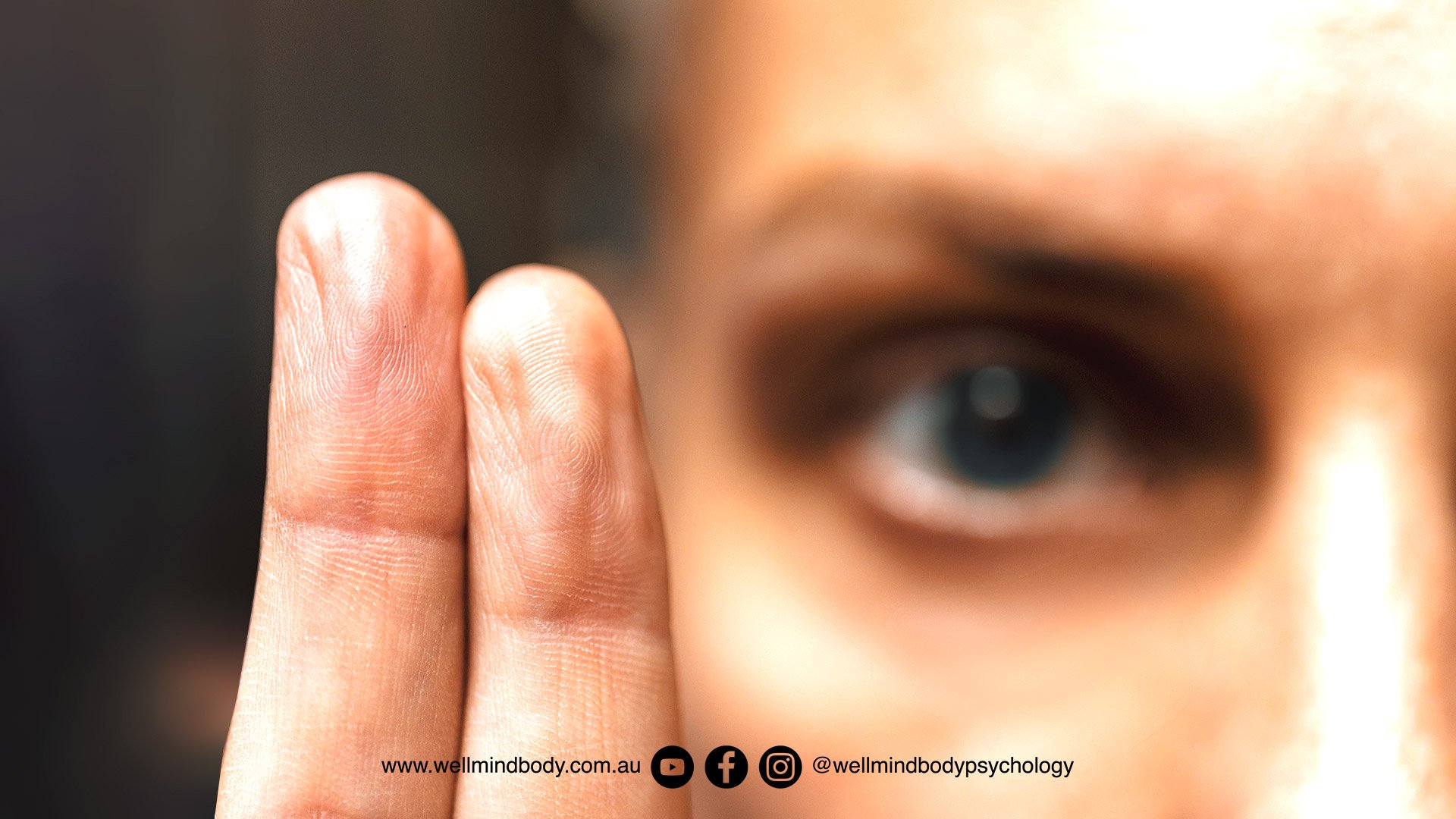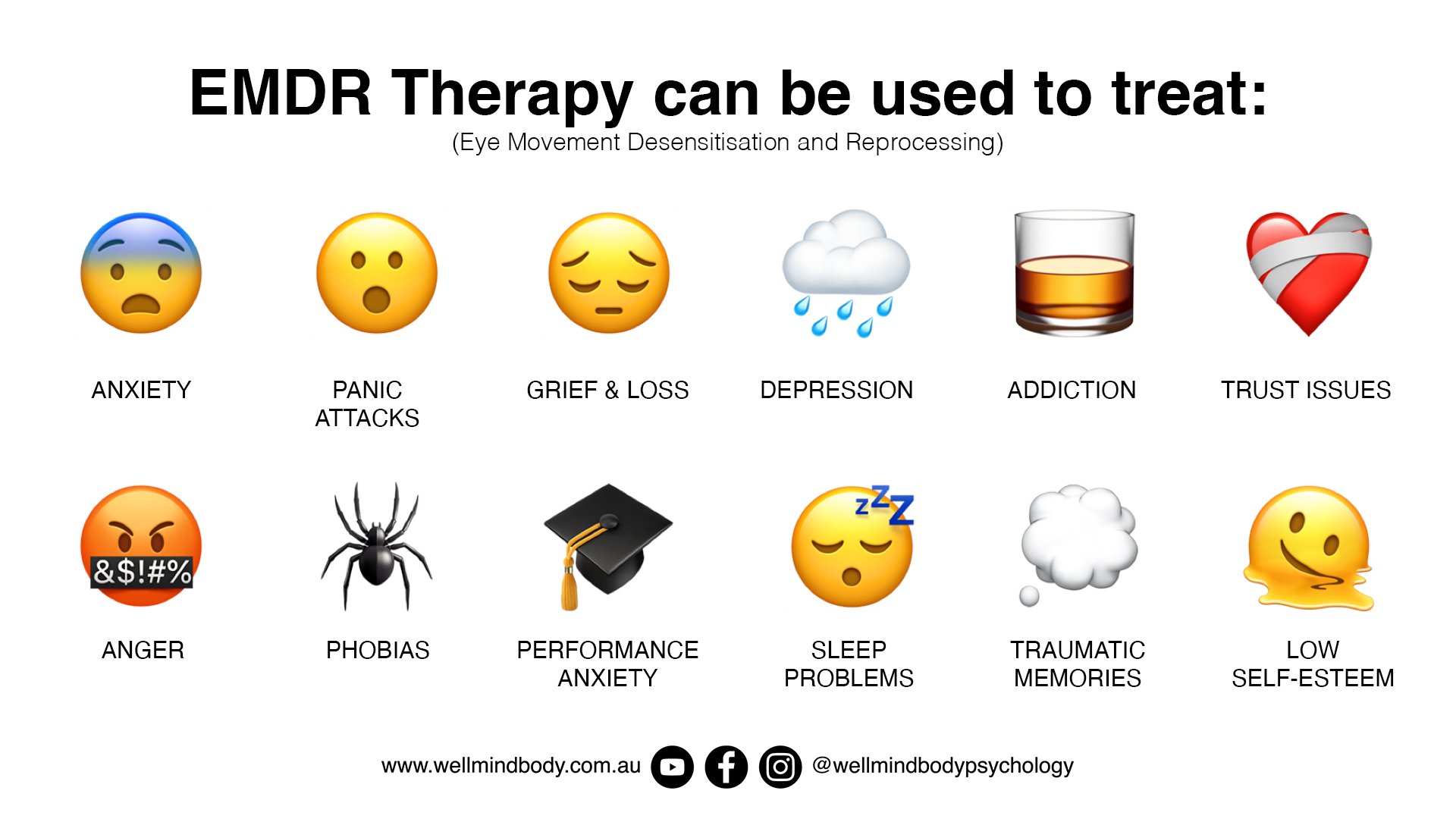EMDR Therapy for PTSD, Anxiety & Trauma
What is EMDR?
Eye Movement Desensitisation and Reprocessing (EMDR) is a psychotherapy technique that was initially developed in the 1980’s by Francine Shapiro to reduce the distress associated with traumatic memories.
EMDR is now considered the first line treatment for individuals with Post Traumatic Stress Disorder, over and above other therapeutic modalities and medication. However, EMDR is also gaining recognition for its ability to treat everyday memories that lead people to experience low self-esteem and feelings of powerlessness that may lead to other mental health diagnoses.
Psychologist conducting one form of bilateral stimulation (BLS) during EMDR Therapy - Therapist uses their fingers to direct the clients eye movements from left to right.
How does a traumatic memory differ from a normal memory?
When we experience a traumatic situation, our brains code this memory into three components:
The sensory memory (what we see, smell, hear etc.)
The emotional memory (what we felt)
The meaning or valence we attribute to the situation
These memories are stored in the part of our brain called the limbic system, which we can think of as the oldest and most mammalian-like part of our brains. Back when we were hunting lions and gazelles on the African Savanna, the limbic system elevated chemicals in our body that signalled us to be hyper-alert and ready to chase down our next meal (the fight part, of the fight-or-flight response), or merely survive and run as fast as we can in the other direction (the flight part, of the fight-or-flight response). Memories stored in the limbic system are more readily and easily retrieved due to how important and salient we attribute them to be at the time.
When we recall a traumatic memory stored in the limbic system from decades ago, it may feel as though it happened as recently as yesterday. Our animal brain kicks in and we feel an impending sense of fear, anticipation or heightened alertness. Our body is protecting us, by registering that something dangerous may be present and that we should potentially fight, flight or freeze in response to it. However, by doing this it hijacks the part of our brain that makes us the most human; our pre-frontal cortex, which allows us to regulate our thoughts and feelings, and problem solve appropriately. This automatic response will render us unable to make the connection that this memory is a past experience and that in the present moment we are okay.
Let’s call the memories stored in the limbic system our unprocessed traumatic memories. These memories are often recalled with great vividness and emotional attachment and can be experienced as though they are occurring in the here and now. They might also consist of sensory fragments of the event, rather than a complete and full reconstruction of the memory.
Memories that are processed and integrated are recalled with a clear sense of what is remembered in the past. These memories generally fade over time and lose their vividness and detail and therefore feel like a more distant, understood, and put to rest memory.
What can you expect from an EMDR session?
During EMDR you are guided by your practitioner to bring the unprocessed memory as well as your thoughts, beliefs and the accompanying emotions and bodily sensations about it, into conscious awareness. This is quickly followed by engaging in the “eye movements”, which usually occur by following your therapists’ fingers as they move from left to right.
This bilateral stimulation (the eyes moving from left to right), moves the memory from the emotional part of the brain where it is ‘stuck’ (the mammalian brain) and into the part of the brain that allows cognitive processing (the human brain), which then allows you to experience distance from the event, and to be more anchored in the present moment.
At the end of each set of eye movements you are then asked to report what you notice. It may be that the sensory memory becomes less detailed or vivid, or perhaps that it has changed in nature or feels quite distant or vague. Commonly, the emotional or bodily sensations can also reduce in intensity quite quickly. Simple memories can be treated in a single session, where as older and multiple memories can require several sessions to produce a similar effect.
So how can EMDR help?
EMDR therapy shows that the mind can heal from psychological trauma just as the body recovers from physical trauma. When you cut your hand, your body works to close the wound. If a foreign object or repeated injury irritates the wound, it festers & causes pain. Once the block is removed, healing resumes.
EMDR demonstrates that a similar sequence of events occurs in the mind. The brain’s information processing system naturally moves towards improved mental health. If the system is blocked, the emotional wound festers and can cause internal suffering. Once the block is removed, healing resumes.
EMDR therapy combines aspects from clients past (distressing memories), present (current situations causing distress and avoidance behaviours) and future (developing skills and attitudes for positive future actions) to facilitate healing and post-traumatic growth.
Why eye movements?
There are several proposed theories to explain why bilateral stimulation is so effective in reducing the distress associated with a traumatic memory. The eye movements in EMDR have an effect on our physiology, similar to that which is experienced during REM sleep. REM sleep is involved in the processing of the events of the day and the elimination of unnecessary information. When we sleep, our eyes pivot left to right in what are called saccades which aid in the retention and integration of memories.
By replicating this state during an EMDR session, we allow for the unprocessed, traumatic memories to be reintegrated into the present-memory network. This relieves the “charged” nature of the memory, leaving us with just a memory rather than the emotions and physiological responses associated with it from the past, that we’re previously triggering that fear/anxiety response.
Summing up
I hope my writings have provided some clarity surrounding EMDR, and the wonderful outcomes it has to offer. Your brain is a powerful tool with the power to change its physiology and psychology moment-to-moment. Although at times our brain seems to cause us to react in ways that don’t always make sense to us, it does so to keep us safe, and has our best interests at heart!
EMDR is a wonderful therapeutic technique that can help you make sense of these reactions, your past experiences and the beliefs you have formed about yourself because of them. This leads you experience life informed by your past, but living in the present, rather than the other way around.
My own experiences with EMDR and my recent training in the modality have allowed me to experience first-hand, the gift that EMDR offers to be able to help us make sense of challenging past experiences not only in our brain, but in our body too.
You may want to learn more about EMDR and if it is right for you. Please explore the resources below for further reading and contact our practice for assistance in booking a session with one of our clinicians who are trained in EMDR.
— Lauren
Additional Resources
https://www.emdr.com/what-is-emdr/
https://www.emdria.org/about-emdr-therapy/
https://www.apa.org/ptsd-guideline/treatments/eye-movement-reprocessing
Chen, Y. R., Hung, K. W., Tsai, J. C., Chu, H., Chung, M. H., Chen, S. R., Liao, Y. M., Ou, K. L., Chang, Y. C., & Chou, K. R. (2014). Efficacy of eye-movement desensitization and reprocessing for patients with posttraumatic-stress disorder: a meta-analysis of randomized controlled trials. PloS one, 9(8), e103676. https://doi.org/10.1371/journal.pone.0103676
Hill M. D. (2020). Adaptive Information Processing Theory: Origins, Principles, Applications, and Evidence. Journal of evidence-based social work (2019), 17(3), 317–331. https://doi.org/10.1080/26408066.2020.1748155
Lee, C. W., & Cuijpers, P. (2013). A meta-analysis of the contribution of eye movements in processing emotional memories. Journal of behavior therapy and experimental psychiatry, 44(2), 231–239. https://doi.org/10.1016/j.jbtep.2012.11.001
Schubert, S., & Lee, C. W. (2009). Adult PTSD and its treatment with EMDR: A review of controversies, evidence, and theoretical knowledge. Journal of EMDR Practice and Research, 3(3), 117–132. https://doi.org/10.1891/1933-3196.3.3.117
Stickgold, R. (2008). Sleep-Dependent Memory Processing and EMDR Action. Journal of EMDR Practice and Research, 2 (4), p. 289 – 299. DOI: 10.1891/1933-3196.2.4.289.
https://therapist-training.com.au/wp-content/uploads/2016/07/schubert-and-lee-2009-extract.doc.pdf


